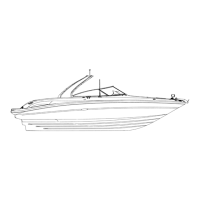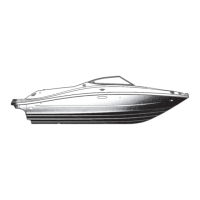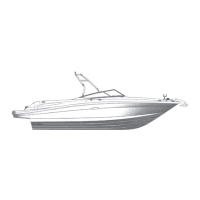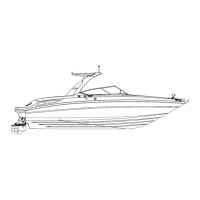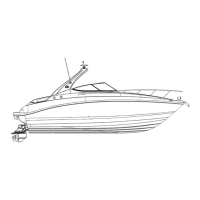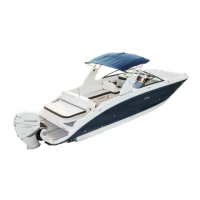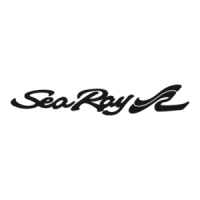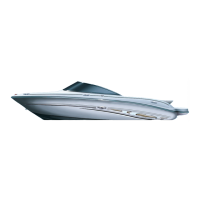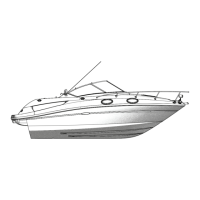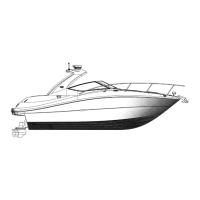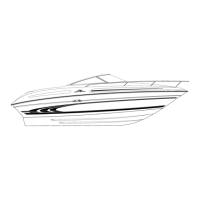Do you have a question about the Sea Ray 270 Select EX and is the answer not in the manual?
Explains manual's purpose, scope, and content regarding boat operation and maintenance.
Outlines owner's duties for safe boat operation, including training and knowledge.
Lists resources for boating courses, safety, and operational information.
Details the dealer's obligations for boat delivery and customer orientation.
Explains warranty coverage and where to find specific warranty information.
Highlights the importance and location of the HIN for identification and correspondence.
Discusses Sea Ray's compliance with safety standards and industry certifications.
Guides on obtaining service, parts, and repairs from authorized Sea Ray dealers.
Explains the function and importance of safety labels throughout the boat.
Lists essential safety equipment required by the U.S. Coast Guard for boat operation.
Details fire extinguisher requirements and actions to take in case of a fire.
Warns about carbon monoxide hazards and outlines prevention measures for safe operation.
Covers the types, requirements, and proper use of Personal Flotation Devices (PFDs).
Lists extra safety gear recommended for enhancing boating safety.
Emphasizes the dangers of operating the boat under the influence of alcohol or drugs.
Explains how to determine and adhere to the boat's maximum load capacity for safety.
Advises on engine and accessory selection, considering performance and warranty implications.
Discusses propeller selection, maintenance, and the importance of using the correct pitch.
Explains boat stability and factors that can affect it, like load distribution.
Provides guidelines for maintaining control of the boat in various conditions and situations.
Details boat design categories and essential weather-related safety rules for operation.
Stresses the importance of charting a course and filing a float plan for navigational safety.
Outlines safety precautions for engaging in water sports like swimming and skiing.
Guides on responding to medical emergencies, water rescues, and onboard fires.
Lists important contact numbers for obtaining boating safety information and assistance.
Mentions compliance with international standards for vessel construction and safety.
Addresses environmental concerns such as fuel spillage and proper waste disposal.
Defines key nautical terms to help users understand boating terminology.
Explains the meaning of symbols used on boat controls, gauges, and diagrams.
Illustrates the placement of various warning labels on the boat for safety awareness.
Discusses regulations and penalties for dumping trash and garbage into marine waters.
Provides guidance on proper procedures for docking, lifting, and storing the boat safely.
Advises on safe passenger placement and movement within the boat during operation.
Describes the boat's stern drive propulsion system and its components.
Lists the boat's key physical dimensions, including length, beam, and draft.
Illustrates the arrangement of major components and features on the boat's deck.
Details the layout of the helm station, including instruments, gauges, and switches.
Identifies the purpose and location of various through-hull fittings and openings.
Explains the operation of primary boat controls such as throttle, shift, and trim.
Introduces essential gauges for monitoring engine and boat systems, including SmartCraft™.
Covers the proper use and requirements for navigation and anchor lights.
Provides a comprehensive checklist for pre-operation, launch, and post-operation procedures.
Details critical safety procedures and precautions for fueling the boat.
Offers instructions and safety tips for safely boarding the boat.
Explains the operator's responsibility for ensuring PFD use by passengers.
Advises on instructing passengers about boat handling and proper seating for safety.
Outlines pre-start checks and step-by-step procedures for starting the boat's engine.
Explains how to engage forward and reverse gears and related operational precautions.
Details the correct procedure for safely stopping the boat's engine and allowing it to cool.
Describes the boat's steering system and emphasizes the need for regular inspections.
Explains the operation and maintenance of the optional windlass for anchor handling.
Addresses regulations and procedures for handling fuel and oil spills in the bilge.
Explains how to operate and manually open the electric sunpad/engine hatch.
Details the importance of the drain plug and how to use it for bilge drainage.
Covers the operation, maintenance, and troubleshooting of the bilge pump system.
Explains the function of the bilge blower in preventing explosive gasoline vapor buildup.
Covers engine and stern drive maintenance, vibration causes, impact, and propeller selection.
Provides general information about propellers, including diameter and pitch characteristics.
Illustrates the layout of various bilge components, pumps, and tanks.
Describes the gasoline fuel system, including tank capacity, vent, and electric fuel valve.
Outlines essential safety precautions for fueling, emphasizing static electricity risks.
Explains the 12-volt DC system, battery maintenance, and charging practices.
Lists the specifications for recommended marine batteries for the boat.
Details the function and location of the battery switch for controlling DC power distribution.
Emphasizes the need for ignition-protected components in the engine compartment.
Identifies fuse locations and provides a chart of fuse ratings for various circuits.
Explains the use of the 12-volt accessory receptacle for powering devices.
Discusses the boat's lighting system and proper bulb replacement procedures.
Describes the optional AC electrical system, including wiring and breaker functions.
Explains the controls and functions of the main AC distribution panel.
Provides instructions for connecting and disconnecting shore power safely.
Describes maintenance for shore power components to prevent corrosion.
Explains the automatic battery charger/converter and its various charging modes.
Details the optional GFI receptacle and its role in protecting against electrical shock.
Discusses electrolytic corrosion, zinc anodes, and galvanic isolators for metal protection.
Explains the anti-corrosion system designed to protect underwater metals.
Mentions the availability of electrical schematics and advises professional service.
Refers to diagrams showing the location of important accessories and components.
Describes the fresh water system, operation, and sanitization procedures.
Explains the water pump and filter maintenance, including cleaning.
Refers to Section 8 for instructions on winterizing the water system.
Details the shower system operation, including the sump pump and float switch.
Explains the operation of the fresh water washdown sprayer.
Describes the gray water system for managing wastewater discharge restrictions.
Mentions different head systems and refers to specific packet information for operation.
Introduces entertainment options, including stereo systems and speakers.
Explains the vent filter's role in controlling odors from the head system.
Details the steering wheel remote controls for stereo and SmartCraft™ display.
Describes the optional water sport tower and its use for activities like skiing.
Explains the fire extinguisher discharge port for quick access during engine compartment fires.
Details the automatic fire extinguisher system and its activation indicators.
Mentions the optional refrigerator and its fuse protection.
Discusses canvas installation, care, and critical safety warnings regarding CO buildup.
Refers to Section 9 for detailed canvas care and maintenance instructions.
Explains the operation and fuse protection for the boat's horn.
Details the operation of the optional spotlight, including controls.
Explains the operation of optional docking lights via the switch panel.
Provides a chart summarizing inspection, service, and maintenance schedules for boat systems.
Offers space to record important boat and engine service-related information.
Outlines inspection procedures for critical boat areas like the bilge, engine, and fuel system.
Provides a checklist for winterizing the boat, covering various systems.
Details inspection procedures for the boat's wiring system, checking connections and insulation.
Covers inspection of fittings, hoses, and clamps for damage, deterioration, and tightness.
Recommends an annual review of topside equipment and critical safety supplies.
Guides on preparing the boat after storage, focusing on fuel system and batteries.
Covers inspection of miscellaneous items like thru-hull fittings, lights, and switches.
Offers advice on securing the boat and removing valuables when it is left unattended.
Explains the procedure for lubricating the boat's seacocks for proper operation.
Provides a checklist for boarding, preparing to depart, underway, and returning.
Warns against using hazardous cleaning materials and advises checking for environmental regulations.
Covers cleaning, waxing, and maintaining fiberglass and gelcoat surfaces for longevity.
Provides guidance on removing stains and scratches without damaging the boat's finish.
Discusses methods to prevent marine growth on boats kept permanently in water.
Explains how to clean and inspect the boat's bottom paint annually.
Covers cleaning and maintaining topside areas, including stainless steel fittings.
Advises on cleaning salt crystals from instruments using soft, damp cloths.
Notes that gauge and switch panels require minimal care, primarily wiping.
Provides instructions for cleaning acrylic plastic sheeting without causing scratches or damage.
Explains proper cleaning, storage, and handling of canvas and clear vinyl components.
Details cleaning and maintenance procedures for exterior upholstery fabrics.
Refers to material manufacturer's guidance for cleaning and maintaining interior upholstery.
